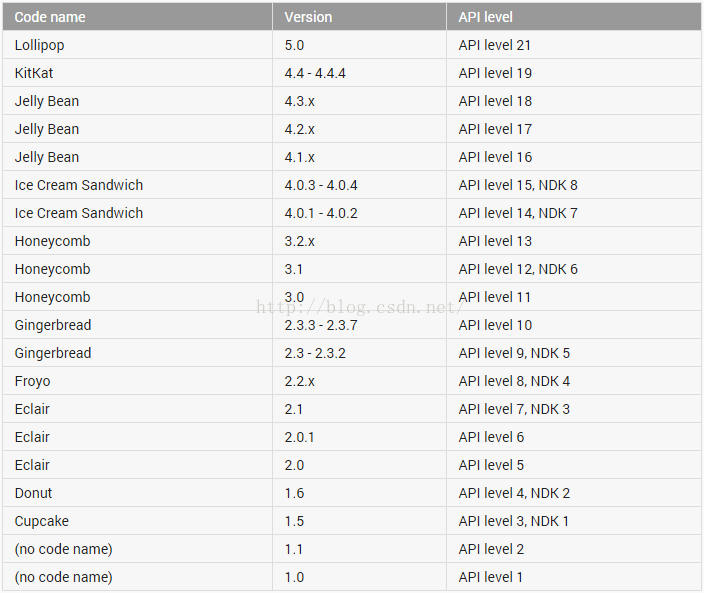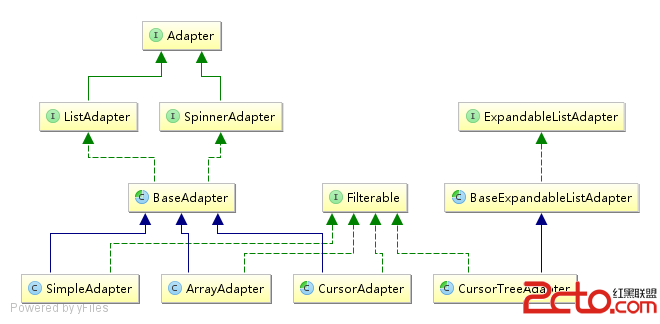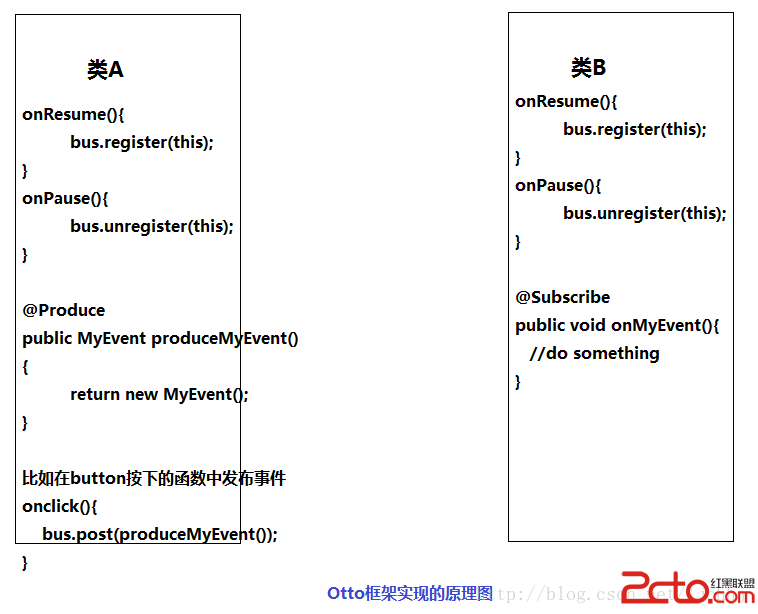編輯:關於Android編程
在前文《Android多線程分析之一:使用Thread異步下載圖像》中演示了如何使用 Thread 處理異步事務。示例中這個 Java Thread 類都是位於 Framework 層的類,它自身是通過 JNI 轉調 dalvik 裡面的 Thread 相關方法實現的。因此要分析 Androd 中的線程,就需要分析這兩層中的與線程相關的代碼,這就是本文要探討的主題。本文將把 Framework 層中的 Java Thread 稱為 Android 線程/Thread,而把 dalvik 中的 Thread 成為 dalvik 線程/Thread。
本文涉及到的 Android 源碼路徑:
android/libcore/luni/src/main/java/java/lang/Runnable.java
android/libcore/luni/src/main/java/java/lang/Thread.java
android/libcore/luni/src/main/java/java/lang/ThreadGroup.java
android/libcore/luni/src/main/java/java/lang/VMThread.java
android/dalvik/vm/native/java_lang_VMThread.cpp
android/dalvik/vm/Thread.cpp
首先來分析 Android Thread,這個類的源碼在android/libcore/luni/src/main/java/java/lang/Thread.java,它實現了 Runnable 接口。Runnable 只有一個無參無返回值的 void run() 的接口:
/**
* Represents a command that can be executed. Often used to run code in a
* different {@link Thread}.
*/
public interface Runnable {
/**
* Starts executing the active part of the class' code. This method is
* called when a thread is started that has been created with a class which
* implements {@code Runnable}.
*/
public void run();
} /**
* A representation of a thread's state. A given thread may only be in one
* state at a time.
*/
public enum State {
/**
* The thread has been created, but has never been started.
*/
NEW,
/**
* The thread may be run.
*/
RUNNABLE,
/**
* The thread is blocked and waiting for a lock.
*/
BLOCKED,
/**
* The thread is waiting.
*/
WAITING,
/**
* The thread is waiting for a specified amount of time.
*/
TIMED_WAITING,
/**
* The thread has been terminated.
*/
TERMINATED
} volatile VMThread vmThread;
volatile ThreadGroup group;
volatile boolean daemon;
volatile String name;
volatile int priority;
volatile long stackSize;
Runnable target;
private static int count = 0;
private long id;
ThreadLocal.Values localValues;vmThread:可視為對 dalvik thread 的簡單封裝,Thread 類通過 VMThread 裡面的 JNI 方法來調用 dalvik 中操作線程的方法,通過它的成員變量 thread 和 vmata,我們可以將 Android Thread 和 dalvik Thread 的關聯起來;
group:每一個線程都屬於一個group,當線程被創建時就會加入一個特定的group,當線程運行結束,會從這個 group 中移除;
daemon:當前線程是不是守護線程,守護線程只會在沒有非守護線程運行的情況下才會運行;
priority:線程優先級,Java Thread 類的線程優先級取值范圍為 [1, 10],默認優先級為 5;
stackSize:線程棧大小,默認為 0,即使用默認的線程棧大小(由 dalvik 中的全局變量 gDvm.stackSize 決定);
target:一個 Runnable 對象,Thread 的 run() 方法中會轉掉該 target 的 run() 方法,這是線程真正處理事務的地方;
id:線程 id,通過遞增 count 得到該id,如果沒有顯示給線程設置名字,那麼就會使用 Thread+id 當作線程的名字;
localValues:線程本地存儲(TLS)數據;
接下來,我們來看Android Thread 的構造函數,大部分構造函數都是通過轉調靜態函數 create 實現的,下面來詳細分析 create 這個關鍵函數:
private void create(ThreadGroup group, Runnable runnable, String threadName, long stackSize) {
Thread currentThread = Thread.currentThread();
if (group == null) {
group = currentThread.getThreadGroup();
}
if (group.isDestroyed()) {
throw new IllegalThreadStateException("Group already destroyed");
}
this.group = group;
synchronized (Thread.class) {
id = ++Thread.count;
}
if (threadName == null) {
this.name = "Thread-" + id;
} else {
this.name = threadName;
}
this.target = runnable;
this.stackSize = stackSize;
this.priority = currentThread.getPriority();
this.contextClassLoader = currentThread.contextClassLoader;
// Transfer over InheritableThreadLocals.
if (currentThread.inheritableValues != null) {
inheritableValues = new ThreadLocal.Values(currentThread.inheritableValues);
}
// add ourselves to our ThreadGroup of choice
this.group.addThread(this);
} public static Thread currentThread() {
return VMThread.currentThread();
}static void Dalvik_java_lang_VMThread_currentThread(const u4* args,
JValue* pResult)
{
UNUSED_PARAMETER(args);
RETURN_PTR(dvmThreadSelf()->threadObj);
}Thread* dvmThreadSelf()
{
return (Thread*) pthread_getspecific(gDvm.pthreadKeySelf);
} /* the java/lang/Thread that we are associated with */
Object* threadObj;接著分析上面的代碼,如果沒有給新線程指定 group 那麼就會指定 group 為當前線程所在的 group 中,然後給新線程設置 name,priority 等。最後通過調用 ThreadGroup 的 addThread 方法將新線程添加到 group 中:
/**
* Called by the Thread constructor.
*/
final void addThread(Thread thread) throws IllegalThreadStateException {
synchronized (threadRefs) {
if (isDestroyed) {
throw new IllegalThreadStateException();
}
threadRefs.add(new WeakReference(thread));
}
} 上面分析的是 Android Thread 的構造過程,從上面的分析可以看出,Android Thread 的構造方法僅僅是設置了一些線程屬性,並沒有真正去創建一個新的 dalvik Thread,dalvik Thread 創建過程要等到客戶代碼調用 Android Thread 的 start() 方法才會進行。下面我們來分析 Java Thread 的 start() 方法:
public synchronized void start() {
if (hasBeenStarted) {
throw new IllegalThreadStateException("Thread already started."); // TODO Externalize?
}
hasBeenStarted = true;
VMThread.create(this, stackSize);
}
}static void Dalvik_java_lang_VMThread_create(const u4* args, JValue* pResult)
{
Object* threadObj = (Object*) args[0];
s8 stackSize = GET_ARG_LONG(args, 1);
/* copying collector will pin threadObj for us since it was an argument */
dvmCreateInterpThread(threadObj, (int) stackSize);
RETURN_VOID();
}bool dvmCreateInterpThread(Object* threadObj, int reqStackSize)
{
Thread* self = dvmThreadSelf();
...
Thread* newThread = allocThread(stackSize);
newThread->threadObj = threadObj;
...
Object* vmThreadObj = dvmAllocObject(gDvm.classJavaLangVMThread, ALLOC_DEFAULT);
dvmSetFieldInt(vmThreadObj, gDvm.offJavaLangVMThread_vmData, (u4)newThread);
dvmSetFieldObject(threadObj, gDvm.offJavaLangThread_vmThread, vmThreadObj);
...
pthread_t threadHandle;
int cc = pthread_create(&threadHandle, &threadAttr, interpThreadStart, newThread);
/*
* Tell the new thread to start.
*
* We must hold the thread list lock before messing with another thread.
* In the general case we would also need to verify that newThread was
* still in the thread list, but in our case the thread has not started
* executing user code and therefore has not had a chance to exit.
*
* We move it to VMWAIT, and it then shifts itself to RUNNING, which
* comes with a suspend-pending check.
*/
dvmLockThreadList(self);
assert(newThread->status == THREAD_STARTING);
newThread->status = THREAD_VMWAIT;
pthread_cond_broadcast(&gDvm.threadStartCond);
dvmUnlockThreadList();
...
}
/*
* Alloc and initialize a Thread struct.
*
* Does not create any objects, just stuff on the system (malloc) heap.
*/
static Thread* allocThread(int interpStackSize)
{
Thread* thread;
thread = (Thread*) calloc(1, sizeof(Thread));
...
thread->status = THREAD_INITIALIZING;
}然後,通過 pthread_create 創建 pthread 線程,並讓這個線程 start,這樣就會進入該線程的 thread entry 運行,下來我們來看新線程的 thread entry 方法 interpThreadStart,同樣只列出關鍵的地方:
/*
* pthread entry function for threads started from interpreted code.
*/
static void* interpThreadStart(void* arg)
{
Thread* self = (Thread*) arg;
std::string threadName(dvmGetThreadName(self));
setThreadName(threadName.c_str());
/*
* Finish initializing the Thread struct.
*/
dvmLockThreadList(self);
prepareThread(self);
while (self->status != THREAD_VMWAIT)
pthread_cond_wait(&gDvm.threadStartCond, &gDvm.threadListLock);
dvmUnlockThreadList();
/*
* Add a JNI context.
*/
self->jniEnv = dvmCreateJNIEnv(self);
/*
* Change our state so the GC will wait for us from now on. If a GC is
* in progress this call will suspend us.
*/
dvmChangeStatus(self, THREAD_RUNNING);
/*
* Execute the "run" method.
*
* At this point our stack is empty, so somebody who comes looking for
* stack traces right now won't have much to look at. This is normal.
*/
Method* run = self->threadObj->clazz->vtable[gDvm.voffJavaLangThread_run];
JValue unused;
ALOGV("threadid=%d: calling run()", self->threadId);
assert(strcmp(run->name, "run") == 0);
dvmCallMethod(self, run, self->threadObj, &unused);
ALOGV("threadid=%d: exiting", self->threadId);
/*
* Remove the thread from various lists, report its death, and free
* its resources.
*/
dvmDetachCurrentThread();
return NULL;
}
/*
* Finish initialization of a Thread struct.
*
* This must be called while executing in the new thread, but before the
* thread is added to the thread list.
*
* NOTE: The threadListLock must be held by the caller (needed for
* assignThreadId()).
*/
static bool prepareThread(Thread* thread)
{
assignThreadId(thread);
thread->handle = pthread_self();
thread->systemTid = dvmGetSysThreadId();
setThreadSelf(thread);
...
return true;
}
/*
* Explore our sense of self. Stuffs the thread pointer into TLS.
*/
static void setThreadSelf(Thread* thread)
{
int cc;
cc = pthread_setspecific(gDvm.pthreadKeySelf, thread);
...
} public void run() {
if (target != null) {
target.run();
}
}/*
* Detach the thread from the various data structures, notify other threads
* that are waiting to "join" it, and free up all heap-allocated storage.
* /
void dvmDetachCurrentThread()
{
Thread* self = dvmThreadSelf();
Object* vmThread;
Object* group;
...
group = dvmGetFieldObject(self->threadObj, gDvm.offJavaLangThread_group);
/*
* Remove the thread from the thread group.
*/
if (group != NULL) {
Method* removeThread =
group->clazz->vtable[gDvm.voffJavaLangThreadGroup_removeThread];
JValue unused;
dvmCallMethod(self, removeThread, group, &unused, self->threadObj);
}
/*
* Clear the vmThread reference in the Thread object. Interpreted code
* will now see that this Thread is not running. As this may be the
* only reference to the VMThread object that the VM knows about, we
* have to create an internal reference to it first.
*/
vmThread = dvmGetFieldObject(self->threadObj,
gDvm.offJavaLangThread_vmThread);
dvmAddTrackedAlloc(vmThread, self);
dvmSetFieldObject(self->threadObj, gDvm.offJavaLangThread_vmThread, NULL);
/* clear out our struct Thread pointer, since it's going away */
dvmSetFieldObject(vmThread, gDvm.offJavaLangVMThread_vmData, NULL);
...
/*
* Thread.join() is implemented as an Object.wait() on the VMThread
* object. Signal anyone who is waiting.
*/
dvmLockObject(self, vmThread);
dvmObjectNotifyAll(self, vmThread);
dvmUnlockObject(self, vmThread);
dvmReleaseTrackedAlloc(vmThread, self);
vmThread = NULL;
...
dvmLockThreadList(self);
/*
* Lose the JNI context.
*/
dvmDestroyJNIEnv(self->jniEnv);
self->jniEnv = NULL;
self->status = THREAD_ZOMBIE;
/*
* Remove ourselves from the internal thread list.
*/
unlinkThread(self);
...
releaseThreadId(self);
dvmUnlockThreadList();
setThreadSelf(NULL);
freeThread(self);
}
/*
* Free a Thread struct, and all the stuff allocated within.
*/
static void freeThread(Thread* thread)
{
...
free(thread);
} Android系統架構
Android系統架構
一、Android歷史2003 年 Andy Rubin 創辦 Android 公司2005 年 Google 收購 Android 公司2007 年成立開放手持設備聯盟
 從Handler+Message+Looper源碼帶你分析Android系統的消息處理機制
從Handler+Message+Looper源碼帶你分析Android系統的消息處理機制
引言【轉載請注明出處:從Handler+Message+Looper源碼帶你分析Android系統的消息處理機制 CSDN 廢墟的樹】作為Android開發者,相信很多人
 [Android學習筆記]Adapter如何進行視圖與數據綁定資料
[Android學習筆記]Adapter如何進行視圖與數據綁定資料
Android開發中視圖和數據的綁定離不開Adapt系列的類,在呈現給用戶的界面友好美觀和內容豐富的應用中視圖為骨,內容為肉,Ad
 Android Otto框架淺析
Android Otto框架淺析
今天要介紹的是一個Android中使用得比較多的android 事件總線 EventBus模式的一個框架Otto。Otto 官網:http://square.github